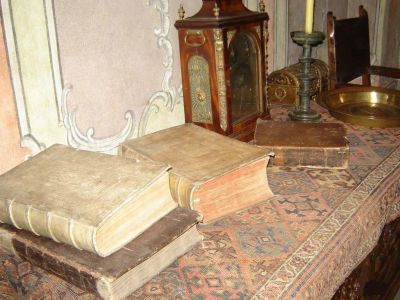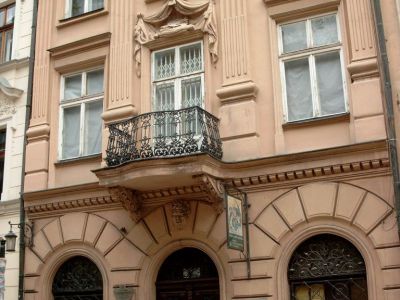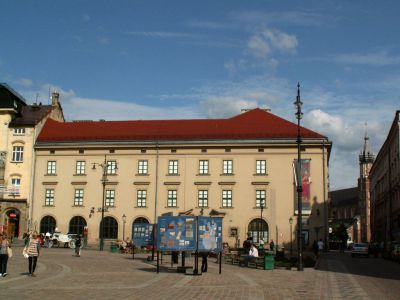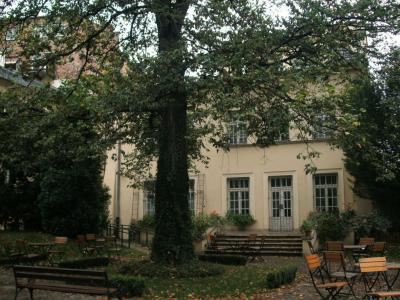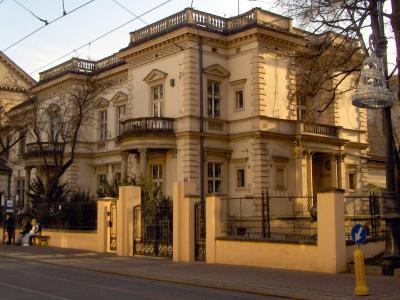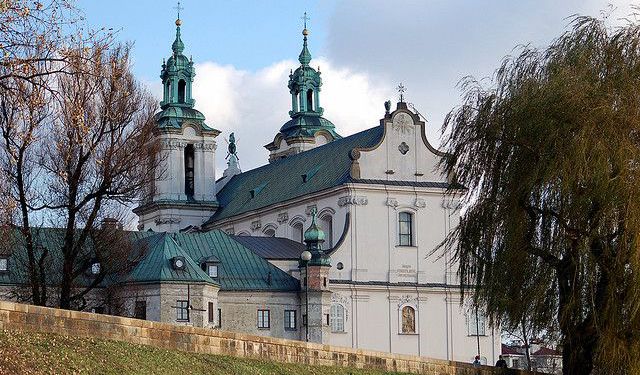
Historical House Museums Tour (Self Guided), Krakow
Well-preserved historical buildings can often tell the stories of their city more vividly than any history book. Krakow, the old capital and cultural center of Poland, for many years, has been the home of many important Poles. Today, their former residences have been converted into house museums where visitors can learn about their inhabitants and see what life was like in the past.
One such back-in-time property is Hipolit House, a beautifully preserved 19th-century townhouse. Serving as a window into the life of Krakow's bourgeoisie during that time, it showcases exquisite period interiors, furnishings, and decorative arts.
Another interesting museum is the Jan Matejko House, dedicated to the renowned Polish painter Jan Matejko. This former residence is where the artist created some of his most famous paintings.
The Wyspiański Museum, housed in the Szołaysky House, celebrates the works of Stanisław Wyspiański, a multifaceted artist and one of Poland's most significant figures from the turn of the 20th century. The museum is filled with his paintings, stained glass designs, and other creations, offering insight into his creative genius.
For those interested in Józef Mehoffer, the Józef Mehoffer House is a true delight. This museum showcases the life and works of the Symbolist painter, stained glass artist, and decorative arts designer. It provides a unique chance to admire his exceptional talent and contribution to the realm of arts.
Last but not least, the Emeryk Hutten-Czapski Museum is a treasure trove of Polish and European art. Housed in a splendid townhouse, it boasts an impressive collection of paintings, sculptures, and decorative objects. It's a place where history and art converge in a splendid display.
So, whenever you're in Krakow, don't miss the chance to explore these fascinating locations. Each one offers a unique perspective on the city's history and artistic legacy, making them essential stops for anyone willing to appreciate the cultural richness of Krakow.
One such back-in-time property is Hipolit House, a beautifully preserved 19th-century townhouse. Serving as a window into the life of Krakow's bourgeoisie during that time, it showcases exquisite period interiors, furnishings, and decorative arts.
Another interesting museum is the Jan Matejko House, dedicated to the renowned Polish painter Jan Matejko. This former residence is where the artist created some of his most famous paintings.
The Wyspiański Museum, housed in the Szołaysky House, celebrates the works of Stanisław Wyspiański, a multifaceted artist and one of Poland's most significant figures from the turn of the 20th century. The museum is filled with his paintings, stained glass designs, and other creations, offering insight into his creative genius.
For those interested in Józef Mehoffer, the Józef Mehoffer House is a true delight. This museum showcases the life and works of the Symbolist painter, stained glass artist, and decorative arts designer. It provides a unique chance to admire his exceptional talent and contribution to the realm of arts.
Last but not least, the Emeryk Hutten-Czapski Museum is a treasure trove of Polish and European art. Housed in a splendid townhouse, it boasts an impressive collection of paintings, sculptures, and decorative objects. It's a place where history and art converge in a splendid display.
So, whenever you're in Krakow, don't miss the chance to explore these fascinating locations. Each one offers a unique perspective on the city's history and artistic legacy, making them essential stops for anyone willing to appreciate the cultural richness of Krakow.
How it works: Download the app "GPSmyCity: Walks in 1K+ Cities" from Apple App Store or Google Play Store to your mobile phone or tablet. The app turns your mobile device into a personal tour guide and its built-in GPS navigation functions guide you from one tour stop to next. The app works offline, so no data plan is needed when traveling abroad.
Historical House Museums Tour Map
Guide Name: Historical House Museums Tour
Guide Location: Poland » Krakow (See other walking tours in Krakow)
Guide Type: Self-guided Walking Tour (Sightseeing)
# of Attractions: 5
Tour Duration: 1 Hour(s)
Travel Distance: 2.0 Km or 1.2 Miles
Author: ellen
Sight(s) Featured in This Guide:
Guide Location: Poland » Krakow (See other walking tours in Krakow)
Guide Type: Self-guided Walking Tour (Sightseeing)
# of Attractions: 5
Tour Duration: 1 Hour(s)
Travel Distance: 2.0 Km or 1.2 Miles
Author: ellen
Sight(s) Featured in This Guide:
- Hipolit House
- Jan Matejko House
- Wyspianski Museum (The Szołaysky House)
- Józef Mehoffer House
- Emeryk Hutten-Czapski Museum
1) Hipolit House
Although museums may be the only window to look at how life was in yester years, rarely do you actually come across one that gives you a feel of how life was back then. The Hipolit House is one of the rare examples which give its viewers an experience of how everyday life was way back in time.
The Hipolit house was once owned by a wealthy Italian merchant family in the 17th century who went by the same name. The mansion saw a number of wealthy families throughout its years and underwent many renovations of its interiors. Today, the museum proudly displays life that the aristocrats lived in 17th century Krakow. Each room of the House is specially decorated to give it a look of the life in Krakow between the 17th and the 20th century.
Interesting exhibits include the Collector’s Room, Young Lady’s Bedroom, The Study and Granny’s room. With intricate details like fabric, furniture, paintings and decorations, one is bound to get transported to the 17th century and so on. This museum is highly recommended if you are a curious about the day to day activity of the years gone by.
Editor's note: Branch temporarily closed.
The Hipolit house was once owned by a wealthy Italian merchant family in the 17th century who went by the same name. The mansion saw a number of wealthy families throughout its years and underwent many renovations of its interiors. Today, the museum proudly displays life that the aristocrats lived in 17th century Krakow. Each room of the House is specially decorated to give it a look of the life in Krakow between the 17th and the 20th century.
Interesting exhibits include the Collector’s Room, Young Lady’s Bedroom, The Study and Granny’s room. With intricate details like fabric, furniture, paintings and decorations, one is bound to get transported to the 17th century and so on. This museum is highly recommended if you are a curious about the day to day activity of the years gone by.
Editor's note: Branch temporarily closed.
2) Jan Matejko House
One of the most renowned Polish artists, Jan Matejko was known for his romantic oil paintings where he beautifully brought out the emotion of the subject on canvas. He is also known for paintings that depict war and political unrest and scenes from the courtroom. He is believed to have instilled a sense of brotherhood in the people of Poland when the country was split due to political unrest. Some of his known oils include 'Battle of Grunwald', 'Stańczyk', 'Copernicus, or Conversations with God', etc.
Jan Matejko House is the mansion which saw the birth and the tragic end of this famous painter. He was born in the house, grew up to be established as one of the finest painters of Poland, after which he briefly left the building. However, during his final years, he returned and lived there until he finally bid adieu to the world. Renovated in 2007-09, the museum showcases the everyday life of Matejko. One can see the artist’s studio with his palette, brushes, painting tools, work desk, his drafts and sketches, paintings and even the bed he breathed his last. Matejko was not only a gifted painter; he was also a collector of interesting artifacts, so much of the house functions as a small museum.
Jan Matejko House is the mansion which saw the birth and the tragic end of this famous painter. He was born in the house, grew up to be established as one of the finest painters of Poland, after which he briefly left the building. However, during his final years, he returned and lived there until he finally bid adieu to the world. Renovated in 2007-09, the museum showcases the everyday life of Matejko. One can see the artist’s studio with his palette, brushes, painting tools, work desk, his drafts and sketches, paintings and even the bed he breathed his last. Matejko was not only a gifted painter; he was also a collector of interesting artifacts, so much of the house functions as a small museum.
3) Wyspianski Museum (The Szołaysky House)
The Wyspianski Museum takes you into the world of Stanislaw Wyspianski, where you are invited to take a closer look at some of his best works and their making. Located in the house of the Szołayski family, the building too, is one of the city’s monumental buildings in its own right. Dating back to the 14th century, the structure underwent several reconstructions and renovations in the 19th and 20th century. Roped in as a part of the National Museum of Krakow in 1904, it has been home to several exhibits and treasures of the city.
Off late, the Szolayski house is playing home to the most prized possession of the city’s recent past – the works of its beloved Stanislaw Wyspianski, along with collections from Feliks Manggha. One of Poland’s most cherished artist of the 19th century, Stanislaw Wyspianski was one of the pioneers who merged modern trends and styles of art with the Polish folksy touch. Unique in his every endeavour, Wyspianski’s was also unofficially tagged as the Fourth Polish Bard.
The museum displays a wide collection of Stanislaw’s sketches, paintings, furniture, documents, stained windows, pastels etc. Although Stanislaw died young, his work lives on as proof of the maestro that he was.
Off late, the Szolayski house is playing home to the most prized possession of the city’s recent past – the works of its beloved Stanislaw Wyspianski, along with collections from Feliks Manggha. One of Poland’s most cherished artist of the 19th century, Stanislaw Wyspianski was one of the pioneers who merged modern trends and styles of art with the Polish folksy touch. Unique in his every endeavour, Wyspianski’s was also unofficially tagged as the Fourth Polish Bard.
The museum displays a wide collection of Stanislaw’s sketches, paintings, furniture, documents, stained windows, pastels etc. Although Stanislaw died young, his work lives on as proof of the maestro that he was.
4) Józef Mehoffer House
One of the most revered artists of the Art Nouveau era in Poland (a key figure of the so-called Young Poland movement), Jozef Mehoffer emerged as a painter in Krakow where he studied at the Academy of Fine Arts from 1887 to 1894.
An accomplished master of graphic art, crayon portraits, chalk drawings and etchings, he tried his hand in various techniques and media, but was particularly successful in decorative arts. Throughout his career, Mehoffer created multiple book covers and illustrations, title cards, ornaments, vignettes, initials, as well as posters, trademarks and banknotes. Also acclaimed for his stained glass and polychrome designs, Jozef Mehoffer rose to international fame by producing stained glass windows for the Gothic Saint Nicholas church in Freiburg, Switzerland.
In 1932, the artist bought a house on Krupnicza Street which happened to be the birthplace of his colleague and friend Stanislaw Wyspianski. Previously, this property had left mark in the history of Krakow as a safe house for resistance activists during insurrections in the mid-19th century when Poland was partitioned between Germany, Austria and Russia.
Other than being purely biographical, the museum carries a great deal of weight in terms of artistic exhibition, featuring interior and other decorations, a number of sculptures, three stained glass windows, 120 oil paintings, drawings, designs of polychrome and stained glass windows, as well as Japanese woodcuts. A lion's share of the family memorabilia, furniture, iconography, photographs, a library and a collection of textiles have been provided by Jozef Mehoffer’s grandson Ryszard, who also helped with their arrangement. The exhibits fill up 16 rooms and reflect perfectly the atmosphere of the artist’s family house at the turn of the 20th century.
An accomplished master of graphic art, crayon portraits, chalk drawings and etchings, he tried his hand in various techniques and media, but was particularly successful in decorative arts. Throughout his career, Mehoffer created multiple book covers and illustrations, title cards, ornaments, vignettes, initials, as well as posters, trademarks and banknotes. Also acclaimed for his stained glass and polychrome designs, Jozef Mehoffer rose to international fame by producing stained glass windows for the Gothic Saint Nicholas church in Freiburg, Switzerland.
In 1932, the artist bought a house on Krupnicza Street which happened to be the birthplace of his colleague and friend Stanislaw Wyspianski. Previously, this property had left mark in the history of Krakow as a safe house for resistance activists during insurrections in the mid-19th century when Poland was partitioned between Germany, Austria and Russia.
Other than being purely biographical, the museum carries a great deal of weight in terms of artistic exhibition, featuring interior and other decorations, a number of sculptures, three stained glass windows, 120 oil paintings, drawings, designs of polychrome and stained glass windows, as well as Japanese woodcuts. A lion's share of the family memorabilia, furniture, iconography, photographs, a library and a collection of textiles have been provided by Jozef Mehoffer’s grandson Ryszard, who also helped with their arrangement. The exhibits fill up 16 rooms and reflect perfectly the atmosphere of the artist’s family house at the turn of the 20th century.
5) Emeryk Hutten-Czapski Museum
Count Emeryk Hutten-Czapski was born on October 17, 1828, in Stankow near Minsk, and he passed away on July 23, 1896, in Kraków. He held the position of Vice-Governor in Saint Petersburg and gained prominence as a significant collector of books, prints, and numismatics. His remarkable collection was curated at his ancestral estate in Stankow, which now lies within modern-day Belarus.
Due to concerns about the collection's safety, considering its proximity to Russia, Count Emeryk Hutten-Czapski took the decision to relocate it to Kraków. In pursuit of this, he acquired a 19th-century palace in 1894, situated on what we now know as 12 Pilsudski Street. This palace was intended to serve as the new home for his collection, but unfortunately, he passed away in 1896 before the construction could be completed.
Following his demise, his wife, Baroness Elzbieta Meyendorff, took charge of finalizing the construction of the addition. Abiding by her husband's wishes, she generously gifted the collection to the city of Kraków in 1904.
The museum underwent a reopening in 1917, only to face closure once more with the advent of World War II in 1939. Subsequently, the collection was safeguarded once again. This closure persisted for an extended period, spanning 70 years, starting from 1939 and keeping the museum away from the public eye.
However, in 2013, a transformation occurred. Thanks to funding provided by the European Union, extensive efforts were directed toward restoring the museum and its accompanying gardens. As a result of these endeavors, the museum was able to fling open its doors to the public once more, marking a new chapter in its storied history.
Due to concerns about the collection's safety, considering its proximity to Russia, Count Emeryk Hutten-Czapski took the decision to relocate it to Kraków. In pursuit of this, he acquired a 19th-century palace in 1894, situated on what we now know as 12 Pilsudski Street. This palace was intended to serve as the new home for his collection, but unfortunately, he passed away in 1896 before the construction could be completed.
Following his demise, his wife, Baroness Elzbieta Meyendorff, took charge of finalizing the construction of the addition. Abiding by her husband's wishes, she generously gifted the collection to the city of Kraków in 1904.
The museum underwent a reopening in 1917, only to face closure once more with the advent of World War II in 1939. Subsequently, the collection was safeguarded once again. This closure persisted for an extended period, spanning 70 years, starting from 1939 and keeping the museum away from the public eye.
However, in 2013, a transformation occurred. Thanks to funding provided by the European Union, extensive efforts were directed toward restoring the museum and its accompanying gardens. As a result of these endeavors, the museum was able to fling open its doors to the public once more, marking a new chapter in its storied history.
Walking Tours in Krakow, Poland
Create Your Own Walk in Krakow
Creating your own self-guided walk in Krakow is easy and fun. Choose the city attractions that you want to see and a walk route map will be created just for you. You can even set your hotel as the start point of the walk.
Jewish Heritage Tour in Krakow
The Jewish community has been an integral part of Krakow since the late 13th century. On the eve of World War II, there were 60,000 Jews living in the city, mostly in the historic Kazimierz neighborhood, which accounted for a quarter of the local population. The old town square in Kazimierz was the center of Jewish life.
During the war, the Nazis separated ethnic Jews from the rest of... view more
Tour Duration: 2 Hour(s)
Travel Distance: 3.1 Km or 1.9 Miles
During the war, the Nazis separated ethnic Jews from the rest of... view more
Tour Duration: 2 Hour(s)
Travel Distance: 3.1 Km or 1.9 Miles
Historical Churches Walking Tour
Krakow, the center of religious life in Poland, was once considered “the Northern Rome” for its multitude of churches. Alongside the new temples continuing to appear in the city today, these remarkable sanctuaries, holding deep historical and cultural significance, still remain the most attractive and interesting to look at.
By far the most iconic of these is the Basilica of Saint Mary. A... view more
Tour Duration: 1 Hour(s)
Travel Distance: 2.2 Km or 1.4 Miles
By far the most iconic of these is the Basilica of Saint Mary. A... view more
Tour Duration: 1 Hour(s)
Travel Distance: 2.2 Km or 1.4 Miles
Krakow Introduction Walking Tour
A unique entry on the list of the World Heritage Sights, Krakow is a recognized center of the academic, artistic and cultural life of Poland. Established in the 7th century as a tiny hamlet at the top of the Wawel Hill, overlooking the Vistula River, it is one of the country's oldest cities. Over the course of the next fifteen centuries it has evolved into the nation's second-largest... view more
Tour Duration: 2 Hour(s)
Travel Distance: 3.0 Km or 1.9 Miles
Tour Duration: 2 Hour(s)
Travel Distance: 3.0 Km or 1.9 Miles
The Most Popular Cities
/ view all
